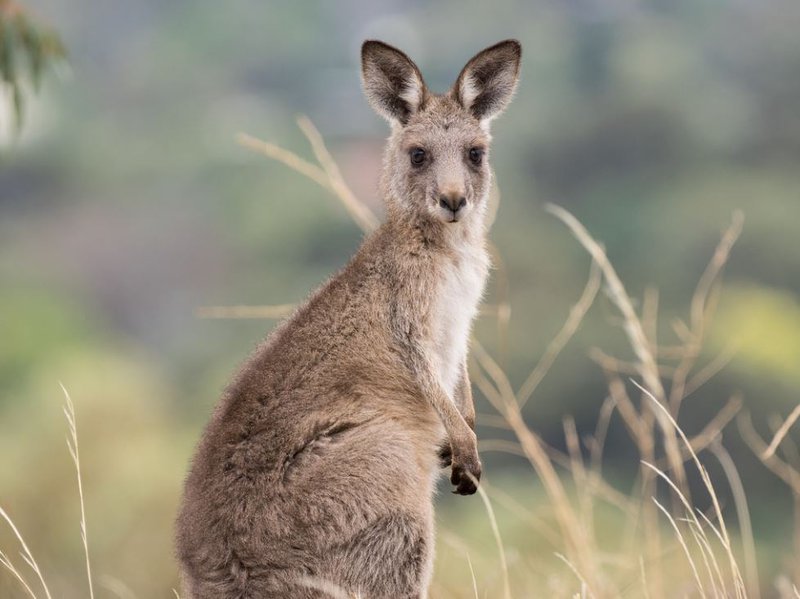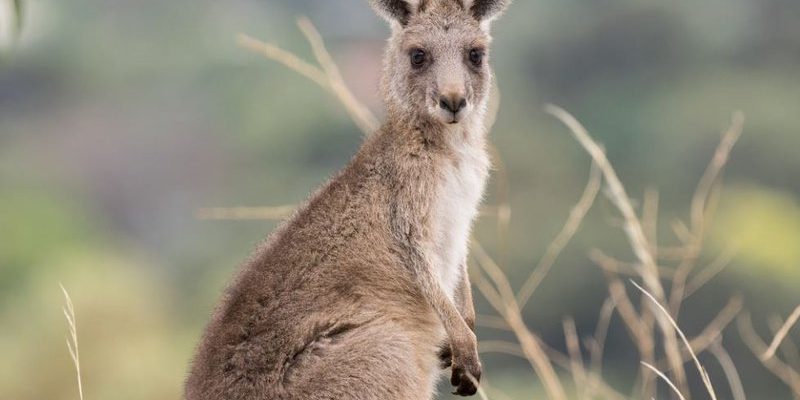
Imagine this: The eastern grey kangaroo is a bit like an Olympic athlete. They’ve adapted their bodies over millions of years to thrive in a unique environment, using their strong legs for impressive leaps and their keen senses for survival. It’s this combination of physical prowess and evolutionary history that makes them a symbol of Australia. Let’s dive into their story and uncover how these remarkable creatures have evolved to become the animals we admire today.
What Are Eastern Grey Kangaroos?
Eastern Grey Kangaroos are large marsupials native to eastern Australia. They can grow as tall as 1.8 meters (about 6 feet) and weigh up to 60 kilograms (around 132 pounds). Physically, they are characterized by their *long legs*, *powerful tails*, and *strong bodies*. Their fur is usually a grey-brown color, which helps them blend into their natural habitat, like woodlands and grasslands.
These kangaroos are herbivores, primarily feeding on grasses, leaves, and shoots. They have a unique digestion system, which allows them to extract the maximum nutrients from their plant-based diet. Think of their stomachs as highly efficient food processors that work tirelessly to sustain their energy needs.
Eastern Grey Kangaroos are also social animals, often seen in groups called *mobs*. These mobs can range from a few individuals to over a hundred, depending on the availability of food and water. Living in a mob offers various advantages, such as protection from predators and social interaction, which is vital for their well-being.
The Origins of Kangaroos
To understand the Eastern Grey Kangaroo better, we must travel back in time. The ancestors of modern kangaroos roamed Australia more than 20 million years ago. These ancient marsupials were likely quite different from the kangaroos we see today. Over millions of years, as the Australian continent evolved and climates changed, these animals adapted to their surroundings.
During the *Miocene Epoch*, which lasted from about 23 to 5 million years ago, kangaroo-like creatures began to diversify. They developed longer limbs and better adaptations for hopping, as this method of locomotion allowed them to cover large distances in search of food and water. Hopping is energy-efficient, which is crucial in a land where resources can be scarce.
So, why the hop? Here’s the thing: hopping allows kangaroos to travel swiftly across vast landscapes, dodging predators and seeking out food. As Australia became drier and more arid, those kangaroos that could hop effectively had the upper hand, leading to the evolution of animals like the Eastern Grey Kangaroo.
Key Adaptations of the Eastern Grey Kangaroo
One of the standout features of the Eastern Grey Kangaroo is its incredible jumping ability. These kangaroos can leap over obstacles up to 3 meters (nearly 10 feet) high and cover distances of 8 to 10 meters (about 26 to 33 feet) in a single bound! This power is thanks to their strong hind legs and large feet, both of which have evolved for maximum propulsion.
Another adaptation worth noting is their ability to regulate body temperature. In the hot Australian climate, Eastern Grey Kangaroos can often be seen lounging in the shade during the heat of the day. They also have a special method of cooling down: by licking their forearms. The saliva evaporates, which helps lower their body temperature—sort of like how we feel cooler after a swim.
These kangaroos also possess a unique social structure that has benefited their survival over the years. Mobs operate under a hierarchy, with dominant males (often called “boomers”) leading the group. This social order allows for cooperation in foraging and predator detection, creating a safer environment for all members.
The Role of Eastern Grey Kangaroos in the Ecosystem
Eastern Grey Kangaroos play a crucial role in their ecosystem. As herbivores, they help control the growth of grass and other vegetation, which, in turn, promotes biodiversity. By grazing on certain plants, they enable other flora to thrive, creating a balanced environment.
Moreover, their presence supports the food chain. Predators such as dingoes and eagles rely on kangaroos as a source of food. Without the Eastern Grey Kangaroo, many of these predators would struggle to find enough nourishment, ultimately affecting the entire ecosystem.
It’s also interesting to note how kangaroo droppings contribute to soil health. Their feces are rich in nutrients, which helps fertilize the ground. This natural process not only enriches the soil but also supports the growth of various plant species, maintaining a healthy environment for all wildlife.
The Impact of Humans on Eastern Grey Kangaroos
As humans expanded into Australia, the relationship with Eastern Grey Kangaroos became more complicated. Initially, Indigenous Australians relied on them for food, clothing, and tools, showing respect for the animals and their place in the ecosystem. However, as European settlement spread, the dynamics shifted dramatically.
With land clearing for agriculture and urban development, the habitats of Eastern Grey Kangaroos faced significant threats. As a result, populations began to dwindle in some areas. Yet, these kangaroos have shown remarkable resilience, adapting to urban environments where they now coexist with humans.
Today, Eastern Grey Kangaroos can often be spotted in parks, golf courses, and even suburban areas. They’ve learned to navigate the challenges brought by humans, which is a testament to their adaptability. However, this doesn’t mean that their populations aren’t still at risk. Habitat destruction, vehicle collisions, and hunting continue to pose threats to their survival.
Conservation Efforts for Eastern Grey Kangaroos
Fortunately, many initiatives aim to protect the Eastern Grey Kangaroo and its habitat. Conservation groups work tirelessly to raise awareness about the importance of these animals and their ecosystems. Education programs focus on teaching communities how to coexist with wildlife while maintaining a healthy environment.
Additionally, some regions have implemented protected areas where kangaroos can thrive without the pressures of urban development. Wildlife corridors are also being created to facilitate safe passage for kangaroos and other wildlife. These corridors allow them to move freely between habitats, promoting genetic diversity and healthier populations.
Policy measures, such as restricting hunting and promoting responsible land use, are crucial for the long-term sustainability of Eastern Grey Kangaroos. Public support plays a key role in these efforts, as people become more educated about their significance in the ecosystem.
The story of the Eastern Grey Kangaroo is one of resilience, adaptation, and survival. From their ancient ancestors to their presence in modern Australia, these fascinating creatures have weathered countless changes in their environment. They remind us of the incredible power of evolution and the delicate balance of ecosystems.
As we move forward, it’s vital to continue supporting conservation efforts and finding ways to coexist with these remarkable animals. By taking steps to protect their habitats and understanding their role within the ecosystem, we can ensure that future generations will continue to enjoy the sight of kangaroos hopping across the Australian landscape. So next time you see one, take a moment to appreciate the rich evolutionary history that brought them to where they are today!

